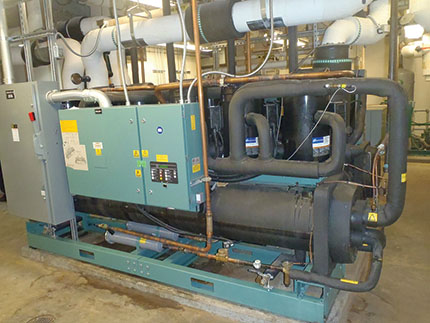Energy managers: Don’t wait to save by Robert Torre
 With summer approaching, energy management experts advise owners and property managers to perform maintenance checks on such equipment as chillers (pictured above). Tenants expect cool and comfortable buildings in the summertime, and undertaking maintenance work during the “shoulder months” of spring helps ensure both comfort and tenant satisfaction.
With summer approaching, energy management experts advise owners and property managers to perform maintenance checks on such equipment as chillers (pictured above). Tenants expect cool and comfortable buildings in the summertime, and undertaking maintenance work during the “shoulder months” of spring helps ensure both comfort and tenant satisfaction.The “shoulder months” of spring and fall are an opportune time for property owners to focus on their energy systems in order to achieve maximum return on investment.
Since demand on heating and cooling systems is lower at this time, owners should assess the condition of their heating and cooling systems to determine adjustments needed to optimize performance while minimizing operating costs and incidence of failure during peak usage times.
The benefits of preventive maintenance, such as reduced emergency repair costs, enhanced customer satisfaction, and energy savings far outweigh the costs.
So get started on the initiatives below to prepare your buildings for the upcoming season.
In the spring:
• Have an experienced and independent HVAC engineer/technician perform “condition assessments” of boilers and associated equipment.
• Perform boiler cleanings and burner tune-ups as necessary.
• For Scotch-marine water and fire tube boilers, maintenance must include tube cleaning if oil is burned.
• Once every five years, clean the water side for possible scale build-up.
• Check that all motors and pumps are functioning.
• Check that all major valves operate properly, including water cut-off and blow-down valves; drain and refill valves as necessary.
• Ensure that chemical water treatment is in place for the season.
It is ideal to replace boilers, if required, during the summer, when there is minimal disruption and no need for hot taps. Considering boiler lead time, which can be anywhere from two to four months after an order is placed, starting your assessment in spring will allow sufficient time for the boiler system to be installed and ready to perform effectively in winter.
In the fall:
• As in the spring, have a qualified HVAC engineer/technician perform “condition assessments” of chillers and other ancillary equipment.
• Check the condition of compressors, condensers and fans.
• For centralized cooling systems, have the factory technician inspect the chiller.
• Perform condenser and evaporator cleanings on a regular basis.
• Check that all chilled and condenser water motors and pumps are functioning -- and perform regular maintenance on these items.
• For water-cooled systems, check cooling tower fans; clean the tower fills and tower basin as needed.
• Make sure condenser water chemical treatment is in place.
• Check all major valves.
• For air handlers, check the condition of belts and filters and replace as needed; perform regular maintenance on motors and fans.
Allow four to six months as lead time for cooling system replacement. Ideally, diagnose a cooling project in the fall-to-winter timeframe so that it can be installed, commissioned and ready for operation in advance of the following summer.
Robert Torre is director of operations at Con Edison Solutions, Valhalla, N.Y.
Over half of Long Island towns vote to exceed the tax cap - Here’s how owners can respond - by Brad and Sean Cronin


How much power does the NYC mayor really have over real estate policy? - by Ron Cohen

The strategy of co-op busting in commercial real estate - by Robert Khodadadian

Oldies but goodies: The value of long-term ownership in rent-stabilized assets - by Shallini Mehra







.png)

.gif)
.jpg)
.gif)